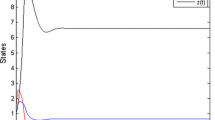Abstract
This paper deals with a discrete-time two prey–one predator system with Holling Type-III functional response, along with inter-specific competition between the prey and intra-specific competition among the predators, with nonlinear harvesting of a prey population. The conditions for existence and local stability of the equilibrium points and the sufficient conditions for global asymptotic stability of the interior equilibrium point are derived. Furthermore, optimal harvesting policy is obtained by extension of Pontryagin’s maximum principle to discrete system. Meanwhile, some numerical simulations are provided to corroborate the analytical results.








Similar content being viewed by others
References
Danca, M., Codreanu, S., Bako, B.: Detailed analysis of a nonlinear prey–predator model. J. Biol. Phys. 23, 11–20 (1997). https://doi.org/10.1023/A:1004918920121
Xu, C., Shao, Y.: Bifurcations in a predator–prey model with discrete and distributed time delay. Nonlinear Dyn. 67, 2207–2223 (2012). https://doi.org/10.1007/s11071-011-0140-1
Murdoch, W.W.: Switching in general predators: experiments on predator specificity and stability of prey populations. Ecol. Monogr. 39, 335–354 (1969)
van Baalen, M., Křivan, V., van Rijn, P.C.J., Sabelis, M.W.: Alternative food, switching predators, and the persistence of predator–prey systems. Am. Nat. 157, 512–524 (2001). https://doi.org/10.1086/319933
Holling, C.S.: The functional response of predators to prey density and its role in mimicry and population regulation. Mem. Entomol. Soc. Can. 97, 5–60 (1965). https://doi.org/10.4039/entm9745fv
Zhuo, X.L., Feng, F.X.: Stability for a new discrete ratio-dependent predator–prey system. Qual. Theory Dyn. Syst. 17, 189–202 (2018). https://doi.org/10.1007/s12346-017-0228-1
Zhuo, X.: Global asymptotic stability for a two-species discrete ratio-dependent predator–prey system. Int. J. Biomath. (2013). https://doi.org/10.1142/S1793524512500647
Mishra, P., Raw, S.N.: Dynamical complexities in a predator–prey system involving teams of two prey and one predator. J. Appl. Math. Comput. (2019). https://doi.org/10.1007/s12190-018-01236-9
Hu, Z., Teng, Z., Zhang, T., Zhou, Q., Chen, X.: Globally asymptotically stable analysis in a discrete time eco-epidemiological system. Chaos Solitons Fractals 99, 20–31 (2017). https://doi.org/10.1016/j.chaos.2017.03.042
Chen, G., Teng, Z.: On the stability in a discrete two-species competition system. J. Appl. Math. Comput. 38, 25–39 (2012). https://doi.org/10.1007/s12190-010-0460-1
Kar, T.K., Matsuda, H.: Global dynamics and controllability of a harvested prey–predator system with Holling type III functional response. Nonlinear Anal. Hybrid Syst. 1, 59–67 (2007). https://doi.org/10.1016/j.nahs.2006.03.002
Sengupta, S., Das, P., Mukjerjee, D.: Stochastic non-autonomous Holling type-III prey–predator model with predator’s intra-specific competition. Discrete Contin. Dyn. Syst. B 23, 3275–3296 (2018). https://doi.org/10.3934/dcdsb.2018244
Huang, Y., Chen, F., Zhong, L.: Stability analysis of a prey–predator model with holling type III response function incorporating a prey refuge. Appl. Math. Comput. 182, 672–683 (2006). https://doi.org/10.1016/j.amc.2006.04.030
Lamontagne, Y., Coutu, C., Rousseau, C.: Bifurcation analysis of a predator–prey system with generalised Holling type III functional response. J. Dyn. Differ. Equ. 20, 535–571 (2008). https://doi.org/10.1007/s10884-008-9102-9
Ding, W., Hendon, R., Cathey, B., Lancaster, E., Germick, R.: Discrete time optimal control applied to pest control problems. Involve J. Math. 7, 479–489 (2014). https://doi.org/10.2140/involve.2014.7.479
Zhang, R.L., Wang, W.X., Qin, L.J.: Optimal harvesting policy of discrete-time predator–prey dynamic system with Holling type-IV functional response and its simulation. Appl. Comput. Math. 4, 20–29 (2015)
Wu, T.: Dynamic behaviors of a discrete two species predator–prey system incorporating harvesting. Discrete Dyn. Nat. Soc. (2012). https://doi.org/10.1155/2012/429076
Hochard, J., Finnoff, D.: Gray wolf population projection with intraspecific competition. Nat. Resour. Model. 27, 360–375 (2014)
Jung, T.S., Czetwertynski, S.M.: Niche overlap and the potential for competition between reintroduced bison and other ungulates in southwestern Yukon, Yukon Fiah and Wildlife Branch report TR-13-15 (2013). https://www.sciencebase.gov/catalog/item/5771b8abe4b07657d1a6ccf2
Hansen, R.M., Reid, L.D.: Diet overlap of deer, elk, and cattle in Southern Colorado. J. Range Manag. 28, 43–47 (1975)
Jung, T.S., Stotyn, S.A., Czetwertynski, S.M.: Dietary overlap and potential competition in a dynamic ungulate community in Northwestern Canada. J. Wildl. Manag. 79, 1277–1285 (2015)
Vila, A.R., Borrelli, L., Martinez, L.: Dietary overlap between huemul and livestock in Los Alerces National Park, Argentina. J. Wildl. Manag. 73, 368–373 (2010)
Banerjee, R., Das, P., Mukherjee, D.: Stability and permanence of a discrete-time two-prey one-predator system with Holling type-III functional response. Chaos Solitons Fractals 117, 240–248 (2018)
Wang, L., Wang, M.: Ordinary Difference Equation. Xinjiang University Press, Xinjiang (1991)
Hwang, C.L., Gong, Y., Fan, L.T.: A discrete version of Pontryagin’s maximum principle. Oper. Res. 15, 139–146 (1967). https://doi.org/10.1287/opre.15.1.139
Lenhart, S., Workman, J.T.: Optimal Control Applied to Biological Models. Mathematical and Computational Biology, 1st edn. Chapman & Hall/CRC, London (2007)
Banerjee, R., Das, P., Mukherjee, D.: Stability and permanent co-existence of a discrete-time two-prey one-predator system with harvesting effort. AIP Conf. Proc. 2159, 030002 (2019). https://doi.org/10.1063/1.5127467
Author information
Authors and Affiliations
Corresponding author
Ethics declarations
Conflict of interest
The authors declare that they have no conflict of interest.
Additional information
Publisher's Note
Springer Nature remains neutral with regard to jurisdictional claims in published maps and institutional affiliations.
Rights and permissions
About this article
Cite this article
Banerjee, R., Das, P. & Mukherjee, D. Global dynamics of a Holling Type-III two prey–one predator discrete model with optimal harvest strategy. Nonlinear Dyn 99, 3285–3300 (2020). https://doi.org/10.1007/s11071-020-05490-0
Received:
Accepted:
Published:
Issue Date:
DOI: https://doi.org/10.1007/s11071-020-05490-0




